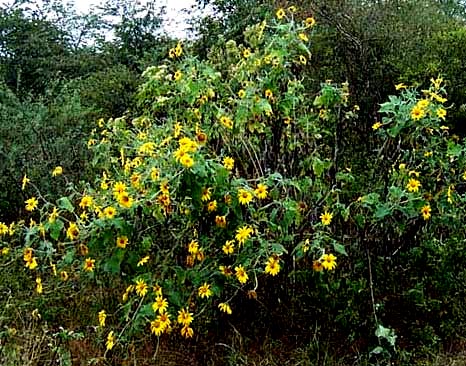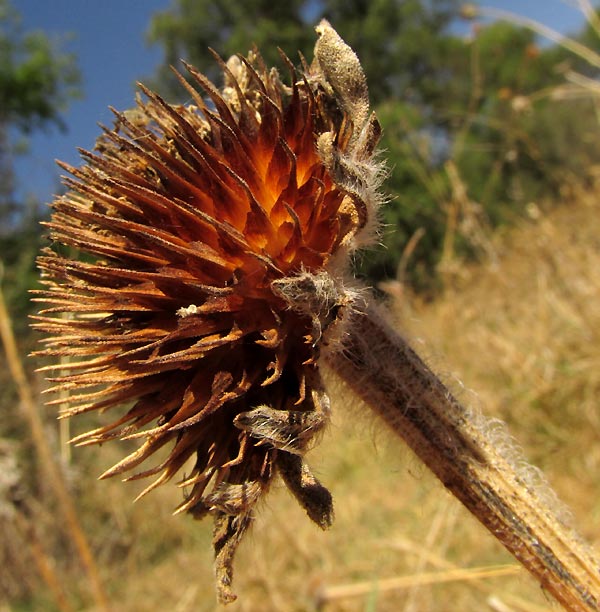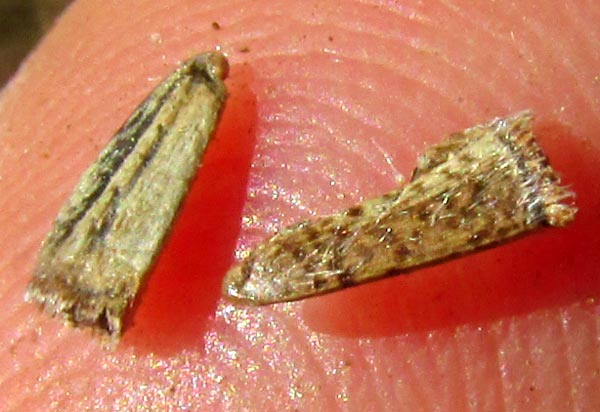Excerpts from Jim Conrad's
Naturalist Newsletter
from the December 11, 2006 Newsletter issued from Sierra Gorda Biosphere Reserve, QUERÉTARO, MÉXICO
ACAHUAL THE PRETTY SUNFLOWER
A certain plant is eye-catching now along roads and in fields. The plant looks a good bit like the North's multi-flowered sunflower species, such as the Jerusalem Artichoke, except it has larger flowers. It's the Acahual, TITHONIA TUBAEFORMIS. You can see one at the Reserve's entrance below.

Beyond the fact that the plant is so big and colorful -- on overcast days the three-inch-wide (7.5 cm), yellow-orange flowers just explode with cheerful brightness -- one reason the species is interesting is because usually weeds are alien invasives, but Acahual is native to here, northeastern Mexico. In fact, the species has begun showing up as a weed in other tropical countries, such as northwestern Argentina. One reason for Acahual's success is that it produces prodigious numbers of little seeds -- to the delight of seed-eating birds.
The name Acahual is from the Náhuatl language and I'm told by Native American employees at the Reserve that the name is applied to several very different weedy plants that appear wherever the ground is disturbed.
entry dated March 27, 2022, issued from near Tequisquiapan, elevation about 1,900m (6200 ft), ~N20.57°, ~ W99.89°, Querétaro state, MÉXICO
ACAHUAL SKELETONS
Now during the latter part of the dry season the landscape could hardly be more sunburned, dusty, dry-crispy and gray-brown. Especially forlorn looking are weedy, fallow fields awaiting the rainy season, or which in recent years have been abandoned because of bad weather and economic stresses. One of the most conspicuous features of many fields are the dead but still standing remains of 2m-tall (6ft) Acahuals, shown below.

In cornfields abandoned for over a year, sometimes the whole field is densely covered with Acahuals. Acahuals are easy to distinguish from other weeds because of their size, and many branches tipped with ball-like, dried-out flowering heads such as the one seen below.

The heads bristle with stiff, spine-tipped scales. These scales are the paleae found separating or partly surrounding the disc florets in many kinds of composite flowers in the huge Composite or Aster Family, the Asteraceae. In the vast majority of species, paleae remain small and may be hard to see, but in the Acahual genus Tithonia as the ovaries mature into cypsela-type fruits -- cypselae being hard, non-splitting fruits bearing just one seed -- the paleae enlarge, harden and stiffen, as you can see.
Even more distinctive for the genus Tithonia is the fact that the flower-head stem, the peduncle, enlarges as it nears the head. Typically peduncles remain the same slender size throughout. You can see that Acahual's club-shaped peduncles also are long, silvery hairy.
One reason to admire Acahual during this season is that it offers such a bounty to seed-eating animals precisely at this time when the scorched earth otherwise seems so barren. During recent months, almost anytime a field thick with Acahuals was approached, flurries of Lark Sparrows, Chondestes grammacus, and House Finches, Haemorhous mexicanus, would rise from the fields and seek shelter in nearby Mesquite trees.
You can imagine that a bird would have a hard time retrieving seed-bearing cypselae from the spiky heads. However, when mature, wind knocks cypselae from the heads onto the ground. Mature cypselae are just 4-6mm long (0.16-0.24inch). This late in the season nearly all the heads' cypselae have tumbled to the ground but one or two in each head usually can be shaken out. Two on the tip of my finger are shown below:

These are distinctive cypselae, being wedge-shaped and a little hairy, with the top of each fruit bearing a low crown of irregularly shaped, irregularly toothed, toothed scales. Sometimes two short spines are present, but these don't have them.